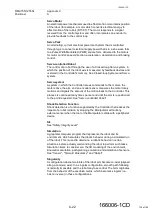
C-18
166006-1CD
166006-1CD
Appendix C
Q
RM2-755/1255SL
Positioner
Programmable Logical Controller (PLC)
A solid-state control system, which has a user programmable memory for
storage of instructions to implement specific functions such as: I/O control
logic, timing, counting arithmetic and data manipulation. A PLC consists of
a central processor, input/output interface, memory and programming
device, which typically uses relay equivalent symbols. The PLC is
purposely designed as an industrial control system, which may perform
functions equivalent to a relay panel or a wired solid-state logic control
system, and may be integrated into the robot control system.
Programmable Robot
A feature that allows a robot to be instructed to perform a sequence of
steps and then to perform this sequence in a repetitive manner. It can then
be reprogrammed to perform a different sequence of steps if desired.
Programming Pendant
A hand-held input device, linked to the control system with which a robot
can be programmed or moved. (ISO 8373) This enables the human
operator to stand in the most favorable position to observe, control and
record the desired movements in the robot's memory.
Proximity Sensor
A non-contact sensing device used to sense when objects are a short
distance away, and it can determine the distance of the object. Several
types include: radio frequency, magnetic bridge, ultrasonic and
photoelectric. Commonly used for: high speed counting, sensing metal
objects, level control, reading coding marks and limit switches. See
Pulse Coordinates
Yaskawa robots define robot joint axes position in degrees for revolute
joints. Pulse is also another way to specify robot joint position, and it does
so in robot motor encoder pulse counts.
Q
Quality Assurance (QA)
Describes the methods, policies and procedures necessary to conduct
quality assurance testing during design, manufacturing and deliver
phases of creating, reprogramming, or maintaining robots.
Quasi-static Clamping
A type of contact between a person and part of a robot system where the
body part can be clamped between the moving part of the robot system &
another fixed or moving part of the robot cell
R
Range of Motion
The full movement potential of the robot.
Reach
The volume of space (envelope), which a robot's end-effector can reach in
at least one orientation.
135 of 145






























